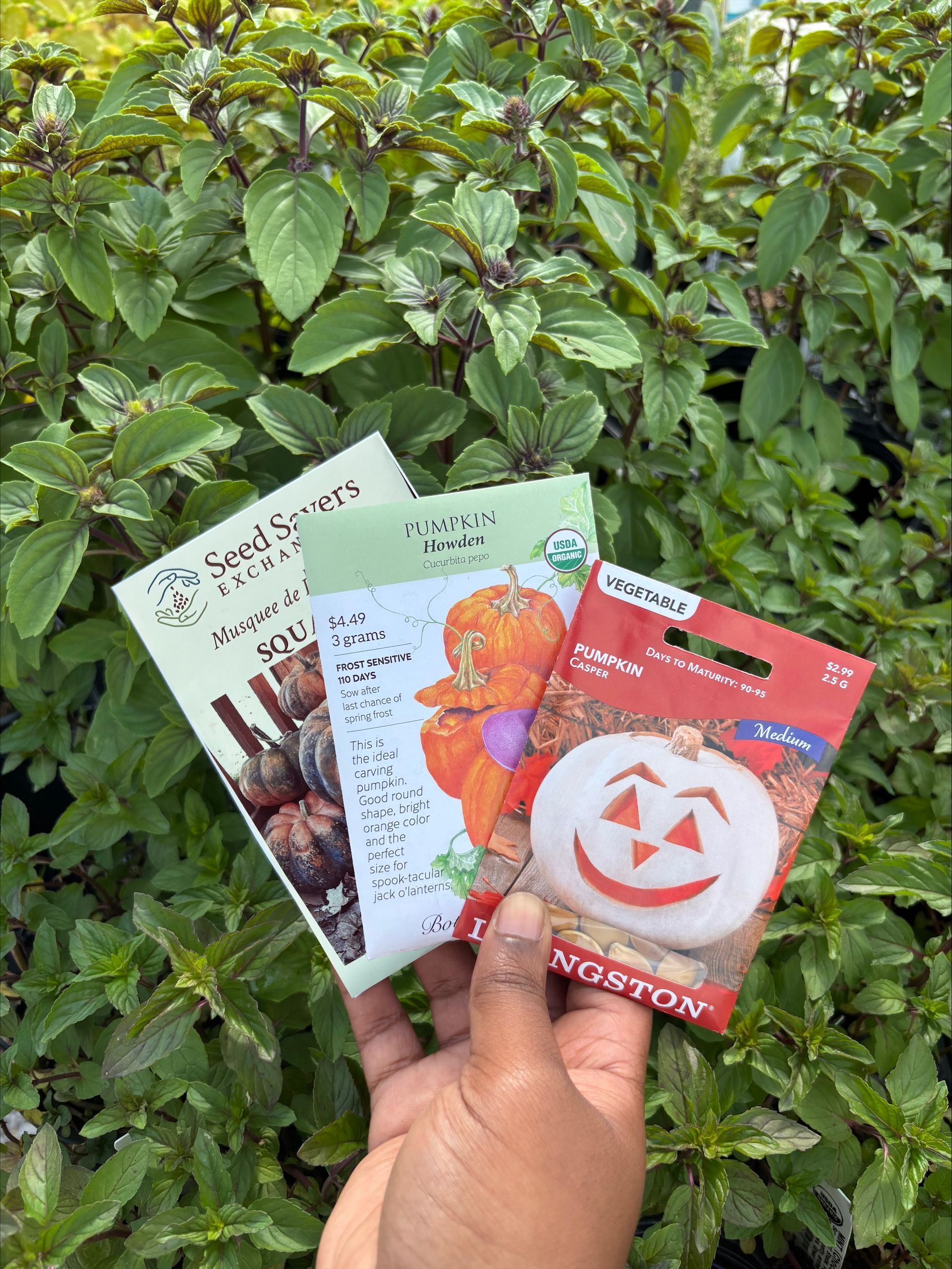Time to Plant Your Pumpkins in Central NC
June 7, 2025
Michael M.
General Manager
Have you ever wanted to grow your own pumpkins? Whether it be for cooking, or for fall decorations, or carving a Jack-o-lantern, NC climate is great for growing your own pumpkins. There are hundreds of varieties, and you can grow white pumpkins, pumpkins that can weight hundreds of pounds, pumpkins that have a rich, deep flavor ideal for cooking and baking, or tiny little pumpkins that are a cute centerpiece for any table in autumn.
Guess, what? Early July is the time!
Right now is a perfect time to grow your own pumpkins, directly from seed. Most pumpkins take appx 90-130 days to grow and mature, so planting a few pumpkin seeds right in late June or early July is the ideal time. There are also lots of smaller pumpkins and gourds that can be ready in 60-80 days. When choosing which pumpkins to grow, simply take your target harvest date (most people will want their pumpkin 1-2 weeks prior to October 31st,) simply count backwards how many “days to maturity” listed on your seed packet to get your ideal planting date. If I want to harvest around Oct 14, and my “days to maturity” is 100 days, I should aim to plant my seeds on July 6th. Also, since most seeds take 5-10 days to germinate, give yourself a few extra days buffer to be safe. Since we are in the beginning of July, I am opting for varieties that mature in 110 days or less, to help ensure I have some great pumpkins ready for carving. Musquee de Provence (110 days), Howden (110 days) and Casper (95days) are the varieties I opted to plant this year.

Okay, but how?
Most pumpkins and gourds will want to be planted about 1” deep, in compost rich soil. They prefer full sun, 8+ hours per day, and fairly consistent watering. I sometimes soak my pumpkin seeds indoors for 6-12 hours prior to planting to get them well hydrated, which can speed up germination and improve germination success. You can start your seeds indoors if you have a short growing season, though I have had more success with direct sowing, and planting a few extra in case some don’t survive. Pumpkins really benefit from being planted in “mounds”, or small piles of nutrient rich soil 8-12” tall. This encourages the sprawling vines to cascade out in different directions. Be sure to water very regularly in the early stages until the plant gets established, and regular deep watering during flowering and fruiting will help ensure a happy, healthy plant. I also aim to only water the soil, not the leaves if possible, to help prevent diseases such as powdery mildew. I also strongly encourage mulching around the base of the plant to help retain moisture, and add to the organic matter. Remember, pumpkins are heavy feeders so be sure your soil is rich in compost, aged manure, or a similar source of aged organic matter.
Once your pumpkin vine is sprawling, and they can sprawl dozens of feet. It’s important to thin the fruits that start forming to help the plant focus its energy on a few fruit, instead of dozens. For smaller pumpkins, you can leave quite a few on the vine, but for very large varieties, thinning will be needed to get great big fruit. People who grow for the purpose of growing the largest pumpkin they can, almost always only leave 1 fruit on the vine. Your flowers will need to be pollinated, so ensure they aren’t covered during the day so your buzzing friends can work their magic. You may notice quite a few flowers before you ever notice a fruit. This is normal, be patient and eventually the plant will produce both female and male flowers which will both be needed for pollination to occur. I also encourage “pinching” off the end of the vine once you see a few pumpkins forming. This will stop the vine from continuing to grow, and help the plant focus on growing big healthy pumpkins. For larger pumpkins, put a flat piece of wood or something similar underneath or find a way to lift slightly away from the soil so they don’t rot if you get a lot of rain.
You did it!
Now, it’s just a waiting game. Give your pumpkins plenty of water, lots of healthy soil rich in organic matter, and as much sun as you can and you should have some home-grown pumpkins ready for fall. You should be ready to harvest when the fruit changes colors, and become a tougher on the exterior. After I cut the fruit off of the vine, I leave it where it is for a few days to allow it to “cure” in the field. This will help prevent it from rotting quickly once brought inside or onto a porch. Now your ready to carve your pumpkin, use it for pie, bread or another favorite recipe, or just set it on a table or porch as decoration.
Good Luck and have fun in the garden!
